46 Expansion and Contraction at the Phrase Level
John Peterson
Key Takeaways
- Expansions make a phrase last longer than expected. They can be internal (between the beginning and ending of the phrase) or external (before the beginning or after the end).
- Internal expansion techniques include repetition, stretching, one-more-time technique, and alternative path.
- External expansions fall into two categories:
- Prefixes occur before the beginning, such as an introduction.
- Suffixes occur after the cadence, such as post-cadential extensions, codettas, and codas.
- Contractions make a phrase shorter than expected.
The terms expansion and contraction refer to ways composers play with the expected length of a phrase.
What does “expected length” mean?
- When a phrase invokes one of the archetypes without following it exactly, we can often identify how long a closer representation of that archetype would have been.
- Sometimes the cadential motion of the phrase allows us to anticipate where a cadence might occur, but the phrase evades the expected cadence.
- Sometimes a piece states two versions of a phrase—one unexpanded and the other expanded—giving us a model to which we can compare the expanded version.
Expansion refers to the process of making a phrase longer than we expect. This lengthening might occur within the phrase (“internal expansion“) or outside of the phrase (“external expansion“). Contraction refers to the process of making a phrase shorter than we expect, and it always occurs within a phrase.
In this chapter, we offer an overview of several techniques for phrase expansion and contraction. This isn’t an exhaustive list, but it covers several of the more common techniques. The terminology concerning expansion and contraction techniques can quickly become overwhelming. What’s most important is to be able to recognize when a phrase is longer or shorter than expected and to be able to describe what’s creating the difference in length.
Internal Expansions
The four techniques we discuss below—repetition, stretching, one-more-time, and alternative path—all occur within a phrase: after the phrase’s beginning, but before its cadence. Often, composers use these techniques in combination; in fact, it’s relatively rare to find a phrase that’s expanded using only one technique.
Repetition
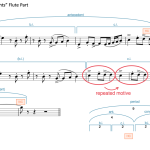
Sometimes when a composer repeats material, the repetition creates extra length.
Example 1 shows an exact repetition of a motive within a unit that creates extra length: a four-measure antecedent is followed by an expanded five-measure consequent. The extra length results from a repeated motive within a unit.
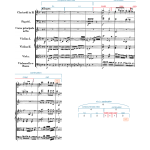
Example 2 shows a varied repetition in which a whole unit is repeated to add extra length: a four-measure compound basic idea (c.b.i.) is followed by a five-measure continuation. The continuation begins with a sequence that expands it from the expected four measures to five.
Not all repetitions create expansion! Be careful to differentiate expansion-creating repetitions, which are unexpected, from more predictable repetitions, such as when the basic idea is repeated in a presentation.
Stretching
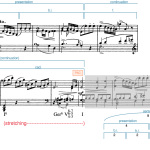
Sometimes composers will lengthen a harmony or melody by increasing its duration so that it lasts longer than expected. When that happens, we say that the unit that contains the harmony or melody has been stretched. In Example 3, a four-measure presentation is followed by a five-measure continuation. The continuation’s cadential idea is stretched when a ![]() chord and the cadential dominant (embellished by a
chord and the cadential dominant (embellished by a ![]() and a cadential
and a cadential ![]() ) each last for a full measure as opposed to both occurring within a single measure.
) each last for a full measure as opposed to both occurring within a single measure.
One-More-Time Technique (o.m.t.)
Coined by Janet Schmalfeldt (1989), the one-more-time technique involves three steps: 1) the music tries to cadence, 2) the attempted cadence is evaded, and 3) the music retries the cadence. The re-tried cadence often uses the same material, such that it feels like the music is “backing up,” but it may also retry the cadence with different cadential material.

In Example 4, a cadence is proposed in m. 10, but it’s evaded (![]() ). A one-more-time repetition of the cadential idea ensues. The one-more-time unit is stretched: notice that it takes two measures (compared to one originally) for the melody to descend C–B♭–A–G, and it takes a full measure (compared to a half measure originally) for the cadential
). A one-more-time repetition of the cadential idea ensues. The one-more-time unit is stretched: notice that it takes two measures (compared to one originally) for the melody to descend C–B♭–A–G, and it takes a full measure (compared to a half measure originally) for the cadential ![]() to resolve to
to resolve to ![]() .
.
Alternative Paths
An alternative path occurs when unexpected new material either temporarily or permanently causes a phrase to deviate from its expected trajectory toward a cadence. A temporary deviation is called a detour. Detours return to previous material from within the phrase before the phrase achieves a cadence. A permanent deviation is called a reroute. Reroutes achieve cadences without returning to previous material from within the phrase.
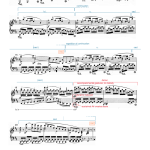
Example 5 shows a detour: the sentence’s continuation is repeated. We realize the repetition is getting “off track” when the motive in the cadential idea (m. 19) is repeated (m. 20), which did not happen in the analogous place before (m. 15). A highly contrasting two-measure passage emerges (mm. 21–22) that leads to a return of material (mm. 23–26) similar to the cadential idea in mm. 19–20, now stretched.
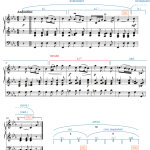
Example 6 shows a reroute: a four-measure antecedent is followed by a six-measure expanded consequent. The consequent begins with the same basic idea as the antecedent, but its contrasting idea moves in a markedly different direction, one that doesn’t lead to a cadence. A new cadential idea is needed to bring the phrase to a perfect authentic cadence (PAC).
Although one-more-time technique and alternative paths both involve cadences, they are very different techniques, as explained below:
| One-more-time technique | Alternative path |
|
|
External Expansions
When composers add length outside of a phrase, they may add measures before the beginning (prefixes) or after the cadence (suffixes). In diagrams, we indicate external expansions using dashed arcs or brackets.
The Prefix
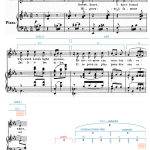
A prefix occurs before the beginning of a phrase, usually taking the form of an introduction. A prefix can be small, but it may also be large, such as when a composer begins a symphony with a slow introduction. Example 7 shows a small prefix. As is very common with songs, this mélodie opens with an instrumental introduction before the singer enters—that is, before the phrase beginningg. Note also that this phrase includes a variant on the typical core bass cadential pattern. Instead of mi-fa-sol-do (![]() ), Chaminade writes di-re-sol-do (
), Chaminade writes di-re-sol-do (![]() ) (mm. 8–11).
) (mm. 8–11).
The Suffix
A suffix occurs after a phrase has cadenced. The terms in Example 8 are flexibly used to describe different types of suffix. While Example 8 provides guidelines for their use, what one person calls a post-cadential extension, another might choose to call a codetta. It’s more important to recognize that a given suffix adds length outside the bounds of a phrase than to worry about which term is most appropriate.
[table “13” not found /]
Example 8. Characteristics that differentiate common suffix types.
Example 9 shows the end of a lengthy period. After the perfect authentic cadence that ends the consequent, a two-measure post-cadential extension prolongs the final tonic via arpeggiation.[1]
In Example 10, a lengthy phrase ends the exposition of the piano sonata with a PAC in A♭ major at m. 41. The cadence is followed by a codetta: notice that it features a repeated two-measure unit harmonized with the cadential bass line fi-sol-do (![]() ).
).
Example 11 features the longest kind of suffix: a coda. After the introduction returns (4:52) and then is varied (5:03), an elided PAC ends the piece proper (5:32). The coda (also at 5:32) presents an energetic celebration of the piece’s closure, featuring a fast version of a previously-heard theme with several phrases.
[table “15” not found /]
Example 11. External expansion via suffix (coda) in Shostakovich, Festive Overture.
Contraction
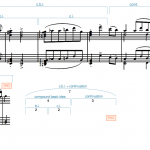
Contractions occur less frequently than expansions. A contraction occurs when a phrase is shorter than we might expect it to be.
In Example 12, a four-measure compound basic idea is followed by a three-measure continuation. Given the length of the compound basic idea, we might have expected the continuation to be four measures long to create proportional balance. As you listen, notice how the cadence feels abrupt, a feeling that usually accompanies contraction.
- Jarvis, Brian, and John Peterson. 2019. “Alternative Paths, Phrase Expansion, and the Music of Felix Mendelssohn.” Music Theory Spectrum 41, no. 2 (Fall): 187–217.
- Schmalfeldt, Janet. 1992. “Cadential Processes: The Evaded Cadence and the ‘One More Time’ Technique.” Journal of Musicological Research 12 (1–2): 1–52.
- Analyzing expansion techniques (.pdf, .docx). Asks students to name, segment, and label the form of excerpts and identify the location of any expansion technique(s). Optional harmonic analysis included. Worksheet playlist
- Analyzing multiple expansion techniques (.pdf, .docx). More complicated examples than in worksheet 1. Each excerpt is significantly expanded. Worksheet playlist
- Recomposing to remove expansions (.pdf, .docx). Asks students to recompose excerpts from worksheet 1 to remove the expanded portion of the archetypal form. Worksheet playlist
- The recording linked is the only commercial recording of the piece. We hope more people will record this beautiful work. ↵
A group of lyrics that is four lines long.
In lyrics, a stanza is a group of lines of lyrics. In music notation, a stanza is a group of staves that are played simultaneously.
In lyrics, a stanza is a group of lines of lyrics. In music notation, a stanza is a group of staves that are played simultaneously.
Use of a minor iv chord in a major key. This creates a semitone descent between scale degrees ↓6̂ and 5̂. It is common to precede iv with IV (major), creating a descent 6̂–↓6̂–5̂.
Use of a minor iv chord in a major key. This creates a semitone descent between scale degrees ↓6̂ and 5̂. It is common to precede iv with IV (major), creating a descent 6̂–↓6̂–5̂.
A Neo-Riemannian transformation that moves both members of the minor third in a triad by semitone, and again changes the mode (e.g., relating C major and F minor).
A Neo-Riemannian transformation that moves both members of the minor third in a triad by semitone, and again changes the mode (e.g., relating C major and F minor).
A meter with three beats per measure.
A meter with four beats per measure.
In set theory, a class is a group whose members are all equivalent in some sense—transposition, inversion, octave, enharmonic, etc.
A group of lyrics that is four lines long.
A type of rest that lasts half the duration of a quarter rest, or the duration of two sixteenth rests.
A subphrase that harmonizes the core bass pattern mi–fa–sol–do (3̂–4̂–5̂–1̂). Functions similarly to a continuation.
An instrument that produces sound via one or more vibrating strings.
A relationship between pitches that share a letter name but are separated by one or more octaves.
A physical and/or social setting.
Auditory; related to hearing.
A note value that lasts half the duration of an eighth note.
A type of motion where a chord tone moves by step to another tone, then moves back to the original chord tone. For example, C–D–C above a C major chord would be an example of neighboring motion, in which D can be described as a neighbor tone. Entire harmonies may be said to be neighboring when embellishing another harmony, when the voice-leading between the two chords involves only neighboring and common-tone motion (as in the common-tone diminished seventh chord).
Key Takeaways
- Nonharmonic tones can be grouped into three categories (summarized in Example 13):
- Involving only stepwise motion: passing tone, neighbor tone
- Involving a leap: appoggiatura, escape tone
- Involving static notes: suspension, retardation, pedal, anticipation
Overview
One of the tools that composers use to make music more interesting is the nonharmonic tone. [pb_glossary id="1347"]Nonharmonic tones[/pb_glossary] are pitches that are added to a composition that are not part of the surrounding chord. The nonharmonic tone creates dissonance which in turn creates momentary musical tension - a really cool effect. In this chapter you will learn about the various different kinds of nonharmonic tones and how they work, and begin to learn how to find them within their musical context.
How to Spot a Nonharmonic Tone
One of the most challenging aspects of learning about nonharmonic tones is learning how to spot them. Once you have spotted the nonharmonic tone, it becomes much simpler to discern what type of nonharmonic tone it is, as the options are fairly limited. The tutorial embedded below, "Desperately Seeking Nonharmonic Tones" gives you a chance to practice finding nonharmonic tones in a musical selection with simple harmony.
Types of Nonharmonic Tones
In this next section we will explore the various types of nonharmonic tones, sometimes called "embellishing tones" or "non-chord tones". These terms all mean the same thing.
Passing tones, neighbor tones: Nonharmonic tones that move by step
Example 1 showed the two kinds of embellishing tones that move by step: passing tones (PTs) and neighbor tones (NTs). Passing tones are approached by step and left by step in the same direction, either ascending or descending (Example 3). Neighbor tones are approached by step and left by step in the opposite direction, producing either an upper neighbor or a lower neighbor (Example 4).
Passing tones by openmusictheory
Example 3. Passing tones in a two-voice texture, (a) ascending and (b) descending.
Neighbor Tones by openmusictheory
Example 4. (a) Upper neighbor and (b) lower neighbor tones in a two-voice texture.
Appoggiaturas and escape tones: Nonharmonic tones that involve a leap
The distinguishing characteristic of appoggiaturas and escape tones is their use of a skip or a leap. Appoggiaturas are approached by skip or leap and left by step in the opposite direction (Example 5). The appoggiatura typically occurs on a stronger part of the beat than its surrounding notes. Escape tones are approached by step and left by skip or leap in the opposite direction (Example 6). The escape tone typically occurs on a weaker part of the beat than its surrounding notes. It is more common for appoggiaturas and escape tones to be left by motion downward (Examples 5a and 6a) than upward (5b and 6b).
Appoggiatura by openmusictheory
Example 7. Appoggiaturas in a two-voice texture.
Escape Tones by openmusictheory
Example 8. Escape tones in a two-voice texture.
Examples 7 and 8 show the two kinds of embellishing tones that involve a leap: appoggiaturas (APPs) and escape tones (ETs).
Joseph Boulogne, String Quartet No. 4, I, mm. 5-9 by openmusictheory
Example 7. An appoggiatura in Joseph Boulogne, String Quartet no. 4, I, mm. 5–9 (0:09-0:19).
ETs in Casson The Cuckoo by openmusictheory
Example 8. An escape tone in Margaret Casson, "The Cuckoo."
Suspensions, anticipations, and pedal tones: Embellishing tones involving static notes
Examples 9–11 show three of the four kinds of embellishing tones that involve static notes (i.e., notes that don't move): suspensions (SUS), retardations (RET), and pedal tones (PED). A fourth kind of embellishing tone, the anticipation, deserves special comment below.
Suspensions are approached by a static note and left by step down, while retardations are approached by a static note and left by step up (Examples 9 and 10). Both suspensions and retardations are always on a stronger part of the beat than the surrounding notes. (Suspensions are discussed in greater detail in the chapter on fourth species counterpoint.)
Pedal tones are often found in the bass. They consist of a series of static notes below chord changes that do not include the bass. We typically label them using the scale degree number of the pedal note, as in Example 11.
Example 9. Suspensions and a retardation in Joseph Boulogne's String Quartet no. 4, I, mm. 47–49 (1:30–1:36).
Example 10. (a) Suspension and (b) retardation in a two-voice texture.
Example 11. Pedal tone in Josephine Lang's "Dem Königs-Sohn," mm. 16–18.
Like the suspension, retardation, and pedal tone, anticipations also involve static notes. But anticipations are a two-note (rather than three-note) gesture, in which a chord tone is heard early as a non-chord tone (Example 12). In other words, it “anticipates” its upcoming membership in a chord.
Example 12. An anticipation in Josephine Lang's "Erinnerung," mm. 29–30 (1:54–1:59).
Summary
The table in Example 13 provides a summary of the embellishing tones covered in this chapter.
[table “41” not found /]
Example 13. Summary of embellishing tones.
- Embellishing tones (.pdf, .mscz). Asks students to write embellishing tones in a two-voice texture and label embellishing tones in an excerpt. Worksheet recording
A vertical line that originates at the notehead, used to indicate rhythm and voicing.
Key Takeaways
- Nonharmonic tones can be grouped into three categories (summarized in Example 13):
- Involving only stepwise motion: passing tone, neighbor tone
- Involving a leap: appoggiatura, escape tone
- Involving static notes: suspension, retardation, pedal, anticipation
Overview
One of the tools that composers use to make music more interesting is the nonharmonic tone. A nonharmonic tone is a pitch that is added to a composition that is not part of the surrounding chord. The nonharmonic tone creates dissonance which in turn creates momentary musical tension - a really cool effect. In this chapter you will learn about the various different kinds of nonharmonic tones and how they work, and begin to learn how to find them within their musical context.
How to Spot a Nonharmonic Tone
One of the most challenging aspects of learning about nonharmonic tones is learning how to spot them. Once you have spotted the nonharmonic tone, it becomes much simpler to discern what type of nonharmonic tone it is, as the options are fairly limited. The tutorial embedded below, "Desperately Seeking Nonharmonic Tones" gives you a chance to practice finding nonharmonic tones in a musical selection with simple harmony.
Types of Nonharmonic Tones
In this next section we will explore the various types of nonharmonic tones, sometimes called "embellishing tones" or "non-chord tones". These terms all mean the same thing.
Passing tones, neighbor tones: Nonharmonic tones that move by step
Example 1 showed the two kinds of embellishing tones that move by step: passing tones (PTs) and neighbor tones (NTs). Passing tones are approached by step and left by step in the same direction, either ascending or descending (Example 3). Neighbor tones are approached by step and left by step in the opposite direction, producing either an upper neighbor or a lower neighbor (Example 4).
Passing tones by openmusictheory
Example 3. Passing tones in a two-voice texture, (a) ascending and (b) descending.
Neighbor Tones by openmusictheory
Example 4. (a) Upper neighbor and (b) lower neighbor tones in a two-voice texture.
Appoggiaturas and escape tones: Nonharmonic tones that involve a leap
The distinguishing characteristic of appoggiaturas and escape tones is their use of a skip or a leap. Appoggiaturas are approached by skip or leap and left by step in the opposite direction (Example 5). The appoggiatura typically occurs on a stronger part of the beat than its surrounding notes. Escape tones are approached by step and left by skip or leap in the opposite direction (Example 6). The escape tone typically occurs on a weaker part of the beat than its surrounding notes. It is more common for appoggiaturas and escape tones to be left by motion downward (Examples 5a and 6a) than upward (5b and 6b).
Appoggiatura by openmusictheory
Example 7. Appoggiaturas in a two-voice texture.
Escape Tones by openmusictheory
Example 8. Escape tones in a two-voice texture.
Examples 7 and 8 show the two kinds of embellishing tones that involve a leap: appoggiaturas (APPs) and escape tones (ETs).
Joseph Boulogne, String Quartet No. 4, I, mm. 5-9 by openmusictheory
Example 7. An appoggiatura in Joseph Boulogne, String Quartet no. 4, I, mm. 5–9 (0:09-0:19).
ETs in Casson The Cuckoo by openmusictheory
Example 8. An escape tone in Margaret Casson, "The Cuckoo."
Suspensions, anticipations, and pedal tones: Embellishing tones involving static notes
Examples 9–11 show three of the four kinds of embellishing tones that involve static notes (i.e., notes that don't move): suspensions (SUS), retardations (RET), and pedal tones (PED). A fourth kind of embellishing tone, the anticipation, deserves special comment below.
Suspensions are approached by a static note and left by step down, while retardations are approached by a static note and left by step up (Examples 9 and 10). Both suspensions and retardations are always on a stronger part of the beat than the surrounding notes. (Suspensions are discussed in greater detail in the chapter on fourth species counterpoint.)
Pedal tones are often found in the bass. They consist of a series of static notes below chord changes that do not include the bass. We typically label them using the scale degree number of the pedal note, as in Example 11.
Example 9. Suspensions and a retardation in Joseph Boulogne's String Quartet no. 4, I, mm. 47–49 (1:30–1:36).
Example 10. (a) Suspension and (b) retardation in a two-voice texture.
Example 11. Pedal tone in Josephine Lang's "Dem Königs-Sohn," mm. 16–18.
Like the suspension, retardation, and pedal tone, anticipations also involve static notes. But anticipations are a two-note (rather than three-note) gesture, in which a chord tone is heard early as a non-chord tone (Example 12). In other words, it “anticipates” its upcoming membership in a chord.
Example 12. An anticipation in Josephine Lang's "Erinnerung," mm. 29–30 (1:54–1:59).
Summary
The table in Example 13 provides a summary of the embellishing tones covered in this chapter.
[table “41” not found /]
Example 13. Summary of embellishing tones.
- Embellishing tones (.pdf, .mscz). Asks students to write embellishing tones in a two-voice texture and label embellishing tones in an excerpt. Worksheet recording
A feature of musical phrasing that features a simulated dialogue between two instruments or groups of instruments.
A Neo-Riemannian transformation that preserves the major third in the triad and moves the remaining note by whole tone (e.g., relating C major and A minor).
A Neo-Riemannian transformation that preserves the perfect fifth in the triad, and moves the remaining note by semitone (e.g., relating C major and C minor).
Key Takeaways
- Nonharmonic tones can be grouped into three categories (summarized in Example 13):
- Involving only stepwise motion: passing tone, neighbor tone
- Involving a leap: appoggiatura, escape tone
- Involving static notes: suspension, retardation, pedal, anticipation
Overview
One of the tools that composers use to make music more interesting is the nonharmonic tone. A nonharmonic tone is a pitch that is added to a composition that is not part of the surrounding chord. The nonharmonic tone creates dissonance which in turn creates momentary musical tension - a really cool effect. In this chapter you will learn about the various different kinds of nonharmonic tones and how they work, and begin to learn how to find them within their musical context.
How to Find a Nonharmonic Tone
One of the most challenging aspects of learning about nonharmonic tones is learning how to spot them. Once you have spotted the nonharmonic tone, it becomes much simpler to discern what type of nonharmonic tone it is, as the options are fairly limited. The tutorial embedded below, "Desperately Seeking Nonharmonic Tones" is designed to help you build this skill.
Passing tones, neighbor tones: Nonharmonic tones that move by step
Example 1 showed the two kinds of embellishing tones that move by step: passing tones (PTs) and neighbor tones (NTs). Passing tones are approached by step and left by step in the same direction, either ascending or descending (Example 3). Neighbor tones are approached by step and left by step in the opposite direction, producing either an upper neighbor or a lower neighbor (Example 4).
Example 3. Passing tones in a two-voice texture, (a) ascending and (b) descending.
Example 4. (a) Upper neighbor and (b) lower neighbor tones in a two-voice texture.
Appoggiaturas and escape tones: Embellishing tones that involve a leap
Examples 5 and 6 show the two kinds of embellishing tones that involve a leap: appoggiaturas (APPs) and escape tones (ETs). Appoggiaturas are approached by leap and left by step in the opposite direction (Example 7). The appoggiatura typically occurs on a stronger part of the beat than its surrounding notes. Escape tones are approached by step and left by leap in the opposite direction (Example 8). The escape tone typically occurs on a weaker part of the beat than its surrounding notes. It is more common for appoggiaturas and escape tones to be left by motion downward (Examples 7a and 8a) than upward (7b and 8b).
Example 5. An appoggiatura in Joseph Boulogne, String Quartet no. 4, I, mm. 5–9 (0:09-0:19).
Example 6. An escape tone in Margaret Casson, "The Cuckoo."
Example 7. Appoggiaturas in a two-voice texture.
Example 8. Escape tones in a two-voice texture.
Suspensions, anticipations, and pedal tones: Embellishing tones involving static notes
Examples 9–11 show three of the four kinds of embellishing tones that involve static notes (i.e., notes that don't move): suspensions (SUS), retardations (RET), and pedal tones (PED). A fourth kind of embellishing tone, the anticipation, deserves special comment below.
Suspensions are approached by a static note and left by step down, while retardations are approached by a static note and left by step up (Examples 9 and 10). Both suspensions and retardations are always on a stronger part of the beat than the surrounding notes. (Suspensions are discussed in greater detail in the chapter on fourth species counterpoint.)
Pedal tones are often found in the bass. They consist of a series of static notes below chord changes that do not include the bass. We typically label them using the scale degree number of the pedal note, as in Example 11.
Example 9. Suspensions and a retardation in Joseph Boulogne's String Quartet no. 4, I, mm. 47–49 (1:30–1:36).
Example 10. (a) Suspension and (b) retardation in a two-voice texture.
Example 11. Pedal tone in Josephine Lang's "Dem Königs-Sohn," mm. 16–18.
Like the suspension, retardation, and pedal tone, anticipations also involve static notes. But anticipations are a two-note (rather than three-note) gesture, in which a chord tone is heard early as a non-chord tone (Example 12). In other words, it “anticipates” its upcoming membership in a chord.
Example 12. An anticipation in Josephine Lang's "Erinnerung," mm. 29–30 (1:54–1:59).
Summary
The table in Example 13 provides a summary of the embellishing tones covered in this chapter.
[table “41” not found /]
Example 13. Summary of embellishing tones.
- Embellishing tones (.pdf, .mscz). Asks students to write embellishing tones in a two-voice texture and label embellishing tones in an excerpt. Worksheet recording
A physical and/or social setting.
1. Write the entire bass
2. Write the entire soprano to make a smooth melody that interacts well with the bass. Choose active notes for the soprano above dominant-function chords, and remember you do not always need to write left to right.
3. Write the inner voices by asking, "What notes do I already have? What notes do I still need? Considering spacing and resolution, what note placement would give me the smoothest motion?"
Occurs when a potential cadence point is declined by the material that follows it. A common strategy is for a composer to write music that proposes a cadence, but then to "back up" in the phrase and try the cadence again. See also the "one-more-time" technique in the chapter on phrase expansion.
Related to European or American culture.
A term that summarizes the quality of the third, fifth, and seventh (if applicable) above the root of the chord. Common chord qualities are major, minor, diminished, half-diminished, dominant, and augmented.
